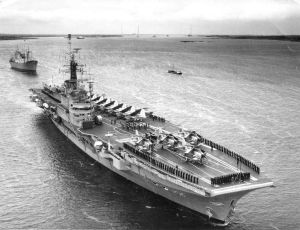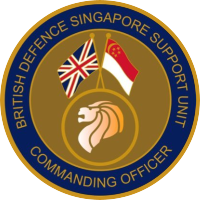
The British Aircraft Corporation (BAC) was a British aircraft manufacturer formed from the government-pressured merger of English Electric Aviation Ltd., Vickers-Armstrongs (Aircraft), the Bristol Aeroplane Company and Hunting Aircraft in 1960. Bristol, English Electric and Vickers became "parents" of BAC with shareholdings of 20%, 40% and 40% respectively. BAC in turn acquired the share capital of their aviation interests and 70% of Hunting Aircraft several months later.

A variable-sweep wing, colloquially known as a "swing wing", is an airplane wing, or set of wings, that may be modified during flight, swept back and then returned to its previous straight position. Because it allows the aircraft's shape to be changed, it is an example of a variable-geometry aircraft.

An interdictor is a type of attack aircraft or tactical bomber that operates far behind enemy lines, with the express intent of air interdiction of the enemy's military targets, most notably those involved in logistics.

HMS Centaur was the first of the four Centaur-class light fleet carriers of the Royal Navy. She was the only ship of her class to be completed with the original design configuration of a straight axial flight deck, rather than the newly invented angled flight decks of her three later sister ships. She was laid down in 1944 in Belfast, with the contract being awarded to Harland and Wolff, but not launched until 22 April 1947 due to delays relating to the end of the war. She was commissioned on 1 September 1953, almost nine years from when she was laid down in 1944.

Royal Air Force Akrotiri, commonly abbreviated RAF Akrotiri is a large Royal Air Force (RAF) military airbase on the Mediterranean island of Cyprus. It is located in the Western Sovereign Base Area, one of two areas which comprise Akrotiri and Dhekelia, a British Overseas Territory, administered as a Sovereign Base Area.

The Blackburn Buccaneer is a British carrier-capable attack aircraft designed in the 1950s for the Royal Navy (RN). Designed and initially produced by Blackburn Aircraft at Brough, it was later officially known as the Hawker Siddeley Buccaneer when Blackburn became a part of the Hawker Siddeley Group, but this name is rarely used.

Royal Air Force Coningsby or RAF Coningsby, is a Royal Air Force (RAF) station located 13.7 kilometres (8.5 mi) south-west of Horncastle, and 15.8 kilometres (9.8 mi) north-west of Boston, in the East Lindsey district of Lincolnshire, England. It is a Main Operating Base of the RAF and home to three front-line Eurofighter Typhoon FGR4 units, No. 3 Squadron, No. 11 Squadron and No. 12 Squadron. In support of front-line units, No. 29 Squadron is the Typhoon Operational Conversion Unit and No. 41 Squadron is the Typhoon Test and Evaluation Squadron. Coningsby is also the home of the Battle of Britain Memorial Flight (BBMF) which operates a variety of historic RAF aircraft.

CVA-01 was a proposed United Kingdom aircraft carrier, designed during the 1960s. The ship was intended to be the first of a class that would replace all of the Royal Navy's carriers, most of which had been designed before or during the Second World War. CVA-01 and CVA-02 were intended to replace HMS Victorious and HMS Ark Royal, while CVA-03 and CVA-04 would have replaced HMS Hermes and HMS Eagle respectively.

The Tengah Air Base is a military airbase of the Republic of Singapore Air Force (RSAF) located in the Western Water Catchment, in the western part of Singapore.

Number 13 Squadron, also written as XIII Squadron, is a squadron of the Royal Air Force which operate the General Atomics MQ-9A Reaper unmanned aerial vehicle from RAF Waddington since reforming on 26 October 2012. The unit first formed as part of the Royal Flying Corps on 10 January 1915 and went on to fly the Martinsyde G.100, the Royal Aircraft Factory F.E.2, the SPAD VII and SPAD XIII, the Sopwith Dolphin during the First World War. In the Second World War it started out operating the Westland Lysander for army cooperation. From late 1942 it used Blenheims in North Africa but in 1943 squadron converted to Ventura for coastal patrols and convoy escort duties. Post war it operated Mosquito before transitioning to the new jet aircraft Gloster Meteor and English Electric Canberra for photoreconnaissance. From 1 January 1990, it operated the Panavia Tornado, initially the GR1A at RAF Honington and later the GR4/4A at RAF Marham where it temporarily disbanded on 13 May 2011.
East of Suez is used in British military and political discussions in reference to interests beyond the European theatre, and east of the Suez Canal, and may or may not include the Middle East. The phrase was popularised by Rudyard Kipling in his 1890 poem "Mandalay". It later became a popular song when a tune was added by Oley Speaks in 1907.

The Sembawang Air Base is a military airbase of the Republic of Singapore Air Force (RSAF) located at Sembawang, in the northern part of Singapore. The base motto is Swift and Resolute.

892 Naval Air Squadron was a carrier-based fighter squadron of the British Royal Navy's Fleet Air Arm. It was formed in 1943, flying Grumman Martlets, and was the only operational Fleet Air Arm squadron to fly the McDonnell Douglas Phantom FG.1.

The Singapore strategy was a naval defence policy of the United Kingdom that evolved in a series of war plans from 1919 to 1941. It aimed to deter aggression by Japan by providing a base for a fleet of the Royal Navy in the Far East, able to intercept and defeat a Japanese force heading south towards India or Australia. To be effective it required a well-equipped base. Singapore, at the eastern end of the Strait of Malacca, was chosen in 1919 as the location of this base; work continued on this naval base and its defences over the next two decades.

BAC/Dassault AFVG was a 1960s project for supersonic multi-role combat aircraft with a variable-sweep wing, jointly developed by British Aircraft Corporation in the United Kingdom and Dassault Aviation of France.
The 1981 Defence White Paper was a major review of the United Kingdom's defence policy brought about by the Conservative government under the Prime Minister Margaret Thatcher. The main author was the then Secretary of State for Defence, John Nott. The aim of the review was to reduce expenditure during the early 1980s recession and to focus on supporting NATO rather than out of area operations. It was ultimately judged however to have been extremely detrimental to the United Kingdom's defence posture, being one of the contributing factors that led to the outbreak of the Falklands War.
899 Naval Air Squadron was a squadron of the Fleet Air Arm of the United Kingdom.

The General Dynamics F-111K was a planned variant of the General Dynamics F-111 Aardvark medium-range interdictor and tactical strike aircraft by General Dynamics, to meet a Royal Air Force requirement for such an aircraft.

The United Kingdom (UK) operated the McDonnell Douglas F-4 Phantom II as one of its principal combat aircraft from 1968 to 1992. The UK was the first export customer for the F-4 Phantom, which was ordered in the context of political and economic difficulties around British designs for the roles that it eventually undertook. The Phantom was procured to serve in both the Royal Navy's Fleet Air Arm (FAA) and the Royal Air Force (RAF) in several roles including air defence, close air support, low-level attack and tactical reconnaissance.

The British Defence Singapore Support Unit (BDSSU) is a British naval facility located in Sembawang, Singapore. A remnant of a larger naval base, known as HMNB Singapore, the facility provides fuel and other supplies to Royal Navy ships in the region, as well as those of other countries. It is the only permanent Royal Navy presence to remain at the former naval base, which is maintained by Naval Party 1022 under the auspices of the Five Power Defence Arrangements (FPDA).
















